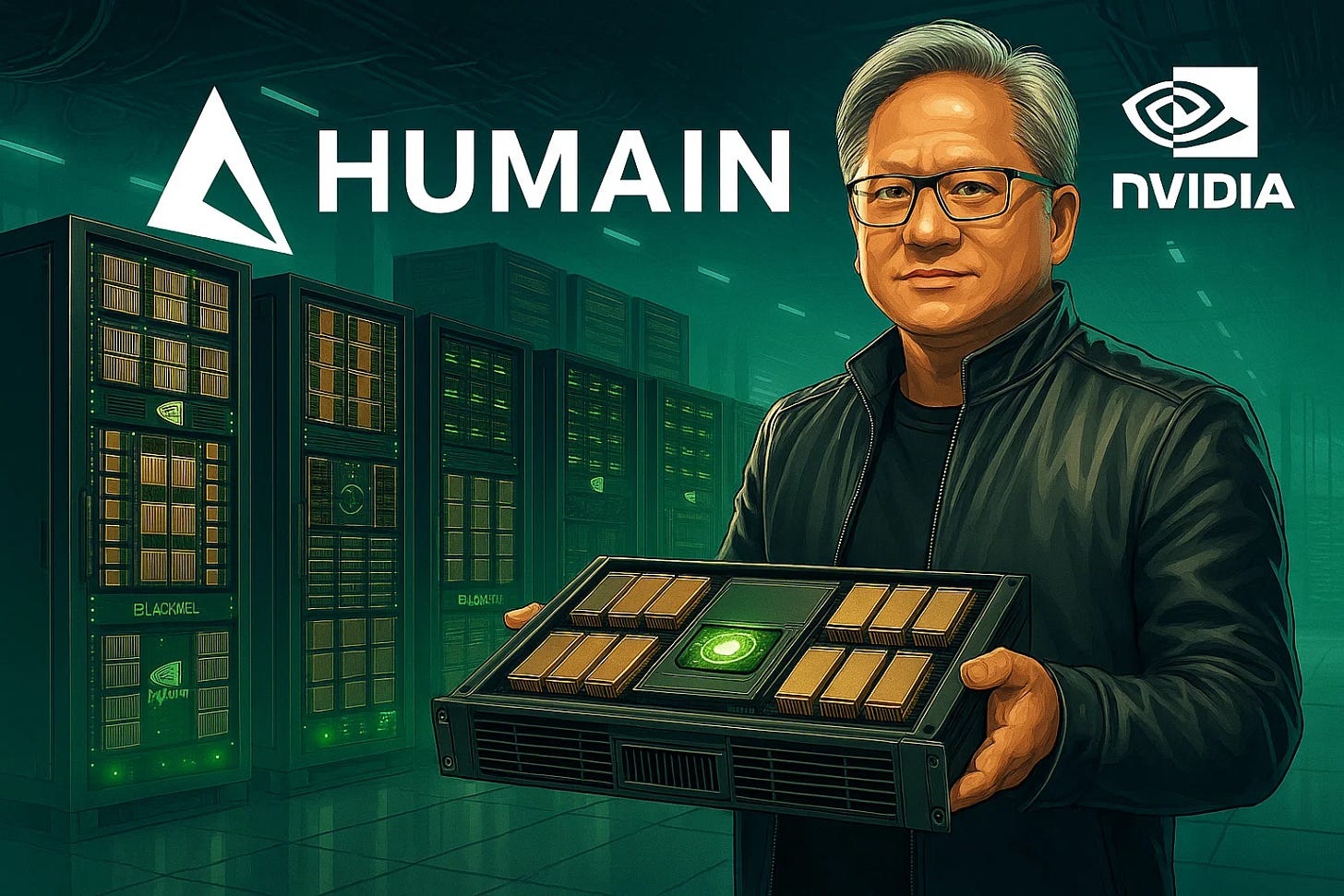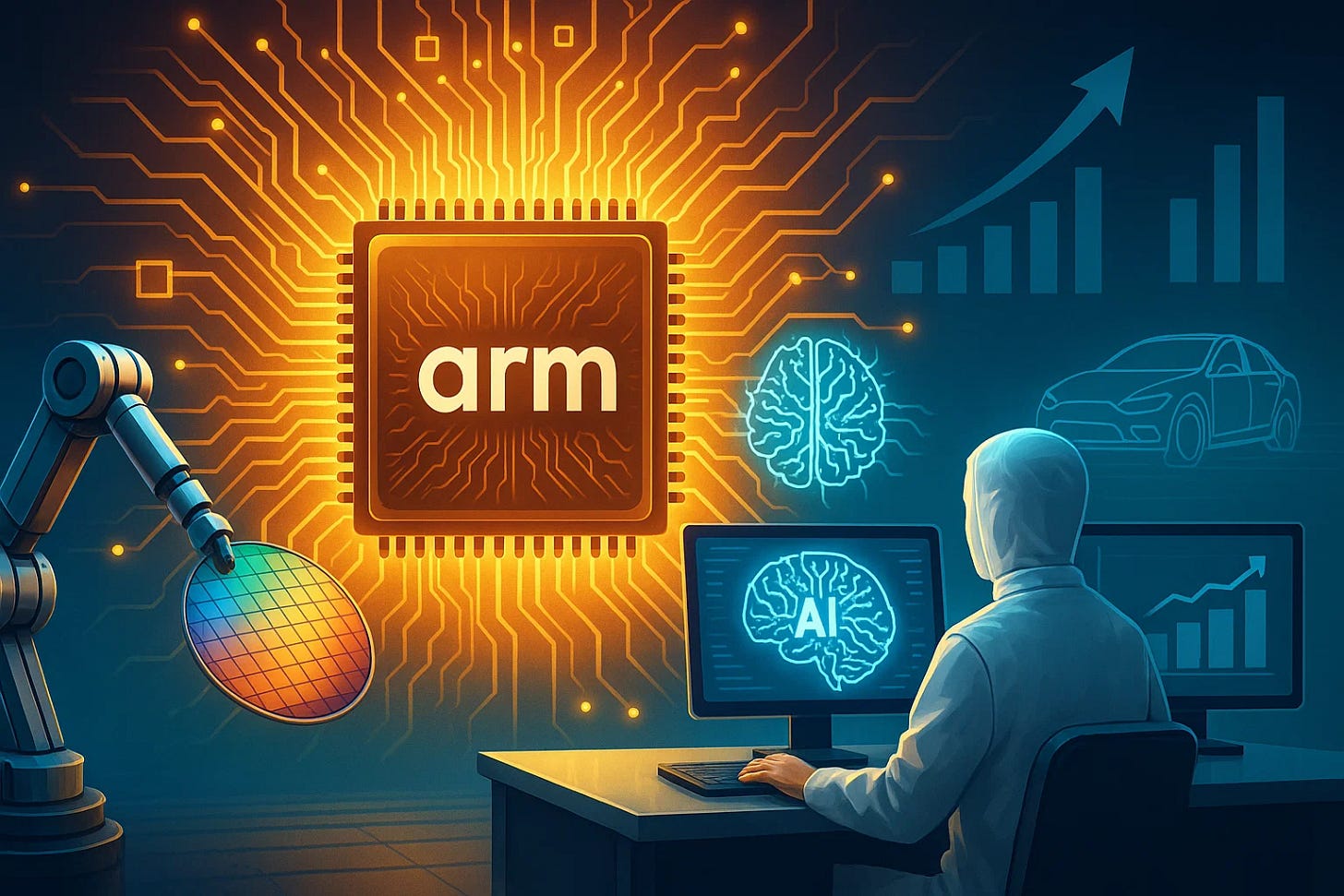90-Day Trade-War Pause & Saudi’s HUMAIN Deal Fuel a New Semiconductor Surge
Welcome, AI & Semiconductor Investors,
A surprise U.S.–China “trade-war truce” slashed tariffs to 30% and 10% through August 10, setting off a wave of bullish sentiment for Semiconductor stocks. At the same time, Saudi Arabia’s HUMAIN initiative just unlocked potential multi-billion-dollar orders for Nvidia, even as Arm shattered the $1 billion revenue mark in Q4 on surging AI licensing and royalties. Let’s Chip In.
What The Chip Happened?
🔔 Big Tariff Slash Spurs Semiconductor Optimism
🚀 Saudi’s HUMAIN: Nvidia’s Next Mega-Customer?
⚡ Arm’s Record Q4 Earnings Fuel AI Ambitions
[Arm Caps Fiscal 2025 with Record-Breaking Q4 Revenue Driven by AI Demand]
Read time: 7 minutes
Semiconductor Market
🔔 Big Tariff Slash Spurs Semiconductor Optimism
What The Chip: On May 12, 2025, the U.S. and China agreed to reduce tariffs sharply for 90 days, down to 30% and 10%, respectively, marking a dramatic de-escalation of tensions. This “trade-war truce” offers semiconductor players like Nvidia a boost in sentiment, though core issues remain unresolved.
The Situation Explained:
🤝 Major Tariff Reductions: The U.S. rolled back its “April blitz” tariffs on Chinese imports from 145% to 30%. China trimmed retaliatory rates to 10% from 125%. This temporary drop far surpasses analysts’ projections of 50–60%.
⏱ 90-Day Countdown: The relief lasts until August 10, 2025. Negotiations continue during this window, but the risk of tariffs snapping back remains if a long-term deal stalls.
⚡ Semiconductor Lift: Beijing already waived some chip tariffs in late April. Now, the broader cuts reduce costs for Chinese buyers of U.S. GPUs and benefit U.S. fab equipment makers. Nvidia, AMD, and ASML see improved sentiment, though export controls remain in place.
💹 Market Surge: S&P 500 and Nasdaq futures rose 3–4%, while the dollar strengthened and Treasury yields climbed eight basis points. Deutsche Bank called the outcome “better than our optimistic expectations.”
🏭 Margin Relief for Importers: U.S. manufacturers and retailers hit by quadrupled tariffs since April (like electronics and auto sectors) gain breathing room. Expect potential gross-margin guidance revisions in upcoming earnings calls.
⚖ Baseline Tariffs Remain: Pre-April duties, averaging roughly 20%, stay intact if no final deal is reached. Structural concerns—like IP protection and export controls—still loom large.
Why AI/Semiconductor Investors Should Care: Lower tariffs on U.S. tech goods create immediate cost advantages for Nvidia and other chipmakers, fueling optimism for near-term sales and margins. However, the 90-day truce underscores the lingering risk that tariffs could snap back and disrupt supply chains if negotiations fail. Investors should monitor trade headlines closely and be prepared for renewed volatility, as this reprieve, while positive, remains temporary.
Nvidia (NASDAQ: NVDA), AMD, AVGO … and other Chip Stocks
🚀 Saudi’s HUMAIN: Nvidia’s Next Mega-Customer?
What The Chip: In a surprise move, reports that U.S. officials granted Saudi Arabia access to Nvidia’s most advanced Blackwell GPUs, reversing earlier export restrictions. CEO Jensen Huang showcased cutting-edge racks for HUMAIN, a new Saudi AI venture aiming to deploy “hundreds of thousands” of top-end chips. If these sales come through, Nvidia could see a multi-billion-dollar boost to its data-center segment.
The Situation Explained:
🏁 Policy U-turn: David Sacks confirmed the U.S. no longer enforces the “diffusion rule” on allied nations like Saudi Arabia, loosening advanced chip export constraints.
🇸🇦 HUMAIN Unveiled: Crown Prince Mohammed bin Salman launched HUMAIN under the Public Investment Fund to build massive data centers and develop an Arabic large language model (LLM). Jensen Huang visited Riyadh to display Blackwell-based GPU racks.
💸 Mega-Spend Potential: Saudi leadership hints at importing “hundreds of thousands” of GPUs, costing billions of dollars if HUMAIN deploys 5k–10k racks. Even a modest $10 billion order could lift Nvidia’s data-center revenue by ~10% in certain fiscal years.
⚙️ Nvidia Ecosystem Pull: Each Blackwell rack ships with NVIDIA AI Enterprise software and specialized networking, producing high-margin recurring revenue. HUMAIN might also adopt AMD or custom ASICs later, but Nvidia stands to gain the lion’s share of initial training needs.
⌛ Supply & Timing Risks: Nvidia’s order backlog is already stretched; channel checks show some lead times through mid-2026. Any Saudi allocation could displace other buyers and be subject to renewed political scrutiny.
🏷️ Biden vs. Trump Approvals: Under Biden’s stricter regime (2024), G42 in the UAE had to adopt U.S.-overseen data centers. Now in 2025, the Trump administration seeks bigger, direct deals with fewer conditions, causing national security debate.
⚠️ Political Whiplash: Critics in Congress warn of dual-use AI tech going to an authoritarian-leaning regime. Future hearings may reimpose caps or demand on-site U.S. audits, creating uncertainty for Nvidia investors.
Why AI/Semiconductor Investors Should Care: Saudi Arabia’s enormous appetite for AI infrastructure could become one of Nvidia’s largest incremental growth drivers, potentially rivaling Chinese hyperscale demand. However, the windfall hinges on whether export rules remain relaxed. For investors, that combo of regulatory volatility and surging global AI demand makes Nvidia a high-reward but closely watched bet.
Arm Holdings plc (NASDAQ: ARM)
⚡ Arm’s Record Q4 Earnings Fuel AI Ambitions
What The Chip: On May 7, 2025, Arm reported its Q4 and full-year 2025 earnings, surpassing $1 billion in quarterly revenue for the first time. Management cited growing demand for power-efficient AI compute, particularly in servers, smartphones, and automotive, as the key catalyst behind the record results.
The Situation Explained:
🔋 Record Revenue & Royalties: Quarterly revenue hit $1.24 billion, fueled by royalty revenue of $607 million, up 18% year-on-year. Arm’s CEO, Rene Haas, said, “We crossed a major milestone in Q4 revenue exceeding $1 billion for the first time ever.”
🏭 Licensing Boom: Licensing revenue jumped 50% year-on-year to $634 million, including a notable multiyear AI deal with the Malaysian government to accelerate the country’s Arm-based chip ecosystem. CFO Jason Child explained, “We continue to diversify our customer base with large agreements.”
☁️ Data Center Gains: Management expects up to 50% of new server chips at major hyperscalers to be Arm-based in 2025. Google’s Action Armv9, Microsoft’s Cobalt 100, and AWS Graviton are cited examples. NVIDIA’s Grace Blackwell CPU platform entered production, reinforcing Arm’s position in AI infrastructure.
📱 Smartphone Strength: Smartphone royalties rose 30% despite industry unit growth of just 2%. This highlights Arm’s increasing value per device as OEMs shift to higher-performance, more power-efficient Armv9 cores.
🚗 Automotive Expansion: New automotive wins—such as GM and NVIDIA’s collaboration on Arm-based Drive AGX—further broaden Arm’s reach. The company also signed its first custom automotive compute subsystem deal with a global EV leader.
🔮 Growing Custom Silicon: More OEMs are designing in-house chips using Arm CPU, GPU, and NPU IP. Haas stressed that “companies turning to Arm for their custom silicon” are driving both licensing and royalty growth.
Why AI/Semiconductor Investors Should Care: Arm’s record earnings underscore its growing foothold in data center AI workloads and its continued diversification across smartphones, automotive, and IoT. Accelerating adoption of custom silicon by hyperscalers and automakers alike signals robust, long-term demand for Arm IP. Despite tariff uncertainties, Arm’s management remains confident in strong royalty growth and heightened R&D investment to support next-generation AI compute, key factors that investors should monitor for ongoing upside potential.
Youtube Channel - Jose Najarro Stocks
X Account - @_Josenajarro
Disclaimer: This article is intended for educational and informational purposes only and should not be construed as investment advice. Always conduct your own research and consult with a qualified financial advisor before making any investment decisions.
The overview above provides key insights every investor should know, but subscribing to the premium tier unlocks deeper analysis to support your Semiconductor, AI, and Software journey. Behind the paywall, you’ll gain access to in-depth breakdowns of earnings reports, keynotes, and investor conferences across semiconductor, AI, and software companies. With multiple deep dives published weekly, it’s the ultimate resource for staying ahead in the market. Support the newsletter and elevate your investing expertise—subscribe today!
[Paid Subscribers] Arm Caps Fiscal 2025 with Record-Breaking Q4 Revenue Driven by AI Demand
Date of Event: May 7, 2025
Executive Summary
*Reminder: We do not talk about valuations, just an analysis of the earnings/conferences
Arm Holdings plc (Arm) closed out its Fiscal Year Ended March 31, 2025, with milestone achievements and strong financial growth, underscored by surging demand for energy-efficient artificial intelligence (AI) compute across data centers, smartphones, automotive platforms, and Internet of Things (IoT) devices. During the fourth quarter (Q4), Arm exceeded USD 1 billion in quarterly revenue for the first time in its history, reaching USD 1.24 billion—an increase of 34% year-over-year. Licensing revenue jumped 53% year-over-year to USD 634 million, while royalty revenue increased 18% year-over-year to USD 607 million. This robust close boosted full-year revenue above USD 4 billion, with royalty revenue surpassing USD 2 billion for the first time.
Management noted that Arm’s growth reflects continued traction across a broad set of end markets. According to Arm Chief Executive Officer Rene Haas, “Q4 marked a record-breaking close to a strong year for Arm, driven by strong demand for power-efficient AI compute from cloud to edge.” Alongside Haas, Chief Financial Officer Jason Child emphasized that multiple flagship smartphone launches, coupled with Arm-based custom silicon in data centers, helped deliver the company’s outstanding finish to fiscal 2025.
Growth Opportunities
Arm’s technology underpins some of the most prominent expansions in AI compute, cloud infrastructure, and custom silicon design. Notably, Arm’s presence in the data center is rising. Management estimates that up to 50% of new server chips at top hyperscalers could be Arm-based this year, with leading cloud service providers, such as Amazon Web Services (AWS), Google Cloud, Microsoft Azure, and NVIDIA Corporation, ramping production of Arm-powered chips.
Data Center and Cloud AI




